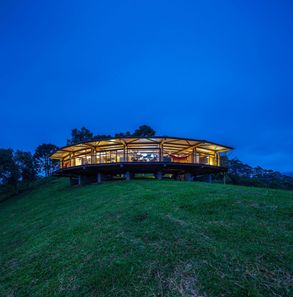Morro Cavado House
WOOD STRUCTURE CONSTRUCTOR
Lourivaldo Vieira Dos Santos E Equipe
WOODWORKS
Marcenaria Pedra Selada (Alvaro Ghizzi)
PARTITION WALLS AND WOOD FINISHING
Paulo Sérgio Do Nascimento E Haleff De Oliveira Nascimento
DESIGN TEAM
Camila Ungaro, Laura Tomiatti, Thiago Benucci
STRUCTURAL ANALYSIS
Arquimedes Costa
AREA
179 m²
MANUFACTURERS
Autodesk, Dupont, Deca, Fogomix, Metavila, Perfilor, Trimble
LOCATION
Bocaina De Minas, Brazil
CATEGORY
Houses
YEAR
2019
Text description provided by architect.
The house is located on the border between Minas Gerais and Rio de Janeiro, in Bocaina de Minas, close to Visconde de Mauá, in the Morro Cavado Valley. Located on the margins of the Itatiaia National Park, its relationship with the terrain and landscape is the fundamental axis of its conception.
The house was shaped by the design of the topography and built using low environmental impact construction techniques, taking advantage of locally available materials and the knowledge and labor of the region.
The arched shape of the house follows the unevenness of the terrain, keeping it level with the access plateau and at the same time slightly elevated from the ground, without the need for large structures or earth moving (leveling).
In addition to providing minimal intervention on the terrain, this arched implantation conforms to the relief, a sloping ridge on the hillside.
The longest perimeter of the arch faces the landscape, creating a visual plane of almost 180º, enhanced by the glass closure along the entire length of the façade, which allows contemplation of the view from any room in the house.
The program is distributed on a single floor, separated into trapezoidal modules that organize the environments. The modules are slices of the arch and are 5 meters on the long side, facing the landscape, to the north, and 3.30 meters on the smaller face, facing south and the entrance plateau.
Access to the residence is via a walkway that connects the plateau to the house, reaching an open and covered porch module. This open module separates the main area of the house from the first module on the left, a guest bedroom, allowing for your privacy and independence.
At the other end of the house, there is another bedroom of identical size, this one connected internally to the living and kitchen environments. This common area, made up of 3 more equal modules, forms a single large integrated living and kitchen environment, constituting the centrality of the project.
The independent structure allowed the exterior walls of the house to be as light as possible, enabling the design of an arched façade, with north/northeast/east faces, composed entirely of wood and glass frames.
All internal walls are made of wood, handcrafted on-site (wood frame). In the entrance face and the sides (south/southwest), where more insulation is needed, the closures are in double layers with wooden boards superimposed externally and in industrialized wood sheets (naval plywood) internally.
The setback of these light frames and closings in relation to the perimeter of the house protects them from the weather while highlighting the closed volume of the plump pillars, it creates a balcony facing the landscape.
The division between each module is delimited by the structural axes, composed of beams and round eucalyptus columns taken from the land itself.
The base of the house is composed of larger diameter trunks, suspended from the ground supported by structural masonry fins (wall sections), located in the center of balance of each beam.
Near the ends of these trunks in symmetrical overhangs, pillars taken from thinner parts of the same trunks are supported.
These pillars are connected at the top, by another round beam, in the slender part of the trunks, this time sloping, to ensure the roof is draped.
All connections between the trunks are made of steel plates and screws, specially designed for the project.
The bathrooms are masonry structures, in adjoining volumes independent of the wooden structure, attached to the bedroom modules, and are supported like boxes directly on the ground.
Although outside the perimeter of the wooden structure, these volumes still fit below the coverage of large eaves, allowing its lining, below the main coverage, to be made of transparent glass, providing ample lighting, but with privacy.
This design decision, in addition to avoiding the contact of wet areas with the wood, facilitates the rise and fall of hydraulic pipes to the land in a more discreet and protected way. The house also has energy generation and water heating systems by capturing solar energy, which makes it practically self-sufficient.



































